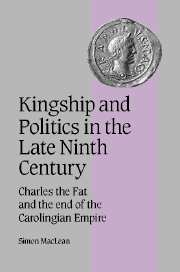 Kingship and Politics in the Late Ninth Century
Kingship and Politics in the Late Ninth Century Book contents
- Frontmatter
- Contents
- List of maps and figures
- Acknowledgements
- List of abbreviations
- Note on names, terminology and citations
- Outline chronology
- Figure 1 The Carolingian family
- Map 1 The late Carolingian empire
- 1 INTRODUCTION
- 2 UN-FRANKISH ACTIVITIES: CHARLES THE FAT IN THE EYES OF CONTEMPORARY ANNALISTS
- 3 THE MEN WHO WOULD BE KINGS: THE ‘SUPERMAGNATES’ AND THE ‘RISE OF THE ARISTOCRACY’
- 4 ROYAL POLITICS AND REGIONAL POWER IN THE LATE CAROLINGIAN EMPIRE
- 5 THE END OF THE EMPIRE I: POLITICS AND IDEOLOGY AT THE EAST FRANKISH COURT
- 6 THE END OF THE EMPIRE II: RESPONSE AND FAILURE
- 7 HISTORY, POLITICS AND THE END OF THE EMPIRE IN NOTKER'S DEEDS OF CHARLEMAGNE
- 8 CONCLUSION
- Bibliography
- Index
- Cambridge Studies in Medieval Life and Thought Fourth Series
4 - ROYAL POLITICS AND REGIONAL POWER IN THE LATE CAROLINGIAN EMPIRE
Published online by Cambridge University Press: 15 July 2009
- Frontmatter
- Contents
- List of maps and figures
- Acknowledgements
- List of abbreviations
- Note on names, terminology and citations
- Outline chronology
- Figure 1 The Carolingian family
- Map 1 The late Carolingian empire
- 1 INTRODUCTION
- 2 UN-FRANKISH ACTIVITIES: CHARLES THE FAT IN THE EYES OF CONTEMPORARY ANNALISTS
- 3 THE MEN WHO WOULD BE KINGS: THE ‘SUPERMAGNATES’ AND THE ‘RISE OF THE ARISTOCRACY’
- 4 ROYAL POLITICS AND REGIONAL POWER IN THE LATE CAROLINGIAN EMPIRE
- 5 THE END OF THE EMPIRE I: POLITICS AND IDEOLOGY AT THE EAST FRANKISH COURT
- 6 THE END OF THE EMPIRE II: RESPONSE AND FAILURE
- 7 HISTORY, POLITICS AND THE END OF THE EMPIRE IN NOTKER'S DEEDS OF CHARLEMAGNE
- 8 CONCLUSION
- Bibliography
- Index
- Cambridge Studies in Medieval Life and Thought Fourth Series
Summary
In the last chapter the case was made that Charles the Fat ruled the empire in much the same way as had his predecessors. However, this observation cannot hide the fact that there was one major difference between the empire of Charlemagne and that of his great-grandson: its political geography. For generations the mental landscape of the Frankish elite had been dominated by political centres in Francia, the middle Rhine, northern Italy and eastern Bavaria, those regions where the Carolingians were best endowed with palaces and estates. Under Charles the Fat, thanks to a series of dynastic accidents, the traditional order of things was turned on its head. His home regnum of Alemannia was very much a political backwater in Carolingian terms. Although other fringe zones such as Provence and Aquitaine had historically hosted resident royal courts, that had been in times of Carolingian numerical strength. Charles never visited Aachen, the old seat of Charlemagne and Louis the Pious, and ruled from Alemannia during a period of dwindling numbers of kings: after 884, it became, along with northern Italy, the centre of the empire. The marchio, a type of regional middle-man who under Charlemagne had been mainly deployed in less-visited frontier regions such as Bavaria, now became a key player in what had previously been the heart of the empire. The political core had become peripheral, and the periphery had become the core.
- Type
- Chapter
- Information
- Kingship and Politics in the Late Ninth CenturyCharles the Fat and the End of the Carolingian Empire, pp. 81 - 122Publisher: Cambridge University PressPrint publication year: 2003
